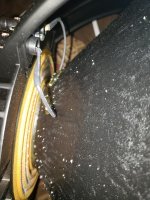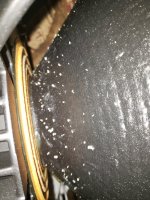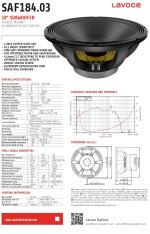If you put the actual measured parameters into the model, how much does it change the ported alignment? I'm guessing not much.
In a ported system, a stiffer suspension is desirable. It doesn't affect the tuning frequency at all and it reduces below-band excursion. For a ported system, I think your higher Fs and higher Q ends up being an advantage, not disadvantage.
I take the opposite route re: your maxim of never tuning a reflex below FS. In my 12 3.5" driver Shaded Array I tuned it an octave below Fs.
In a ported system, a stiffer suspension is desirable. It doesn't affect the tuning frequency at all and it reduces below-band excursion. For a ported system, I think your higher Fs and higher Q ends up being an advantage, not disadvantage.
I take the opposite route re: your maxim of never tuning a reflex below FS. In my 12 3.5" driver Shaded Array I tuned it an octave below Fs.
As said above. Fb lower than Fs have an advantage of increased damping (less prone to ringing).
Anyway, all the QB3, SBB4 etc. alignments are just flat Voltage sensitivity alignments, nothing more, you get a flat frequency response with Voltage source amp, but in the world of DSP/EQ, there is not much benefit of them IMO.
Anyway, all the QB3, SBB4 etc. alignments are just flat Voltage sensitivity alignments, nothing more, you get a flat frequency response with Voltage source amp, but in the world of DSP/EQ, there is not much benefit of them IMO.
I appreciate differing opinions on reflex box tuning. Over the years I've found what sounds best to me for purposes of running the LF up to a midrange driver. This is often up to 500 hz or so depending on the LF driver size and linearity. The tuning which delivers the best midbass to low bass balance and accuracy is what I choose. Most of the time it ends up as a QB3 if the woofer allows for it. For dedicated subs, that may be a different animal altogether. So I can understand different methods and approaches.
Anyways, I took some more pictures of the two 18NW100s before returning them. Here is the silicone crumb carnage...
Anyways, I took some more pictures of the two 18NW100s before returning them. Here is the silicone crumb carnage...
Attachments
The spiders on these subs are absolutely unsuitable for linearity to xmax. After seeing how much the spiders were shedding, I stopped pushing them further. This was only with 18V @ 15 hz. I've learned my lesson and will follow my original rule of not using woofers with narrow, low compliance suspensions.
I forgot to add... I only use sealed boxes for assisted alignments. Ported assisted designs just don't sound clean enough when pushed harder closer to xmax. They're also very sensitive to HP filter applications and don't overload as gracefully. With sealed setups you also won't get peaking group delay in most cases.
The short look I took didn't turn up the 4Ω SAF184.03 specs, but it's over 16 pounds (44.6%) heavier than the 18NW100, that won't change with a preconditioning test 😉
Here's the 4 ohm version of Lavoce SAF184.03
Looks like it has 1mm less xmax and 10 grams more Mms with a tiny bit of extra compliance. I'd say they compromised in the right places for the lower impedance version. The Fs is down by 2 hz as well with the same Qts.
These always have measured accurately for me after light break in. They settle at spec sitting in 20 deg C room temp. Run them harder and the Fs will drop to about 26 hz and come back to 28 hz sitting in room temp.
Attachments
Last edited:
Will be interesting how you think the Lavoce behave in your tests 👍
Half the price of a Faital18XL1800
Half the price of a Faital18XL1800
I've used the 8 ohm SAF184.03 a few times and really liked it, especially for the price. It is a Chinese driver being Lavoce, but is designed by Italians similar to some B&C drivers. I try to seek out those 15s and 18s with under 30 hz Fs and .3 - .4 Qts.
The strength of most Faital stuff is their woofers which play higher up into the mids and can be crossed higher as a 2 way. I don't really like their dedicated sub drivers except for the RS series.
The strength of most Faital stuff is their woofers which play higher up into the mids and can be crossed higher as a 2 way. I don't really like their dedicated sub drivers except for the RS series.
@phase_accurate I took a closer look at that one. At first glance, it does look decent overall, but the actual base sensitivity of 1.05% isn't that good. That's about 92 dB/W, which is average for a larger LF driver and nothing special for a pro driver, even with the amount of VC overhang.
The biggest concern is however the narrow spider, which is a red flag for me if its going in a large ported cab. For an assisted sealed box its a non issue due to enclosure air being the main provision of compliance / suspension spring. If there's any BL offset and its being pushed closer to beyond Fb, the woofer suspension becomes the dominant restorative force, which is much less linear than the air spring.
The other issue is the weird frame format and shape. It doesn't coincide with most other brands and finally, its hard to get a rebuild kit for it. This is why I usually go for B&C, Eminence or 18sound for most larger subs.
The biggest concern is however the narrow spider, which is a red flag for me if its going in a large ported cab. For an assisted sealed box its a non issue due to enclosure air being the main provision of compliance / suspension spring. If there's any BL offset and its being pushed closer to beyond Fb, the woofer suspension becomes the dominant restorative force, which is much less linear than the air spring.
The other issue is the weird frame format and shape. It doesn't coincide with most other brands and finally, its hard to get a rebuild kit for it. This is why I usually go for B&C, Eminence or 18sound for most larger subs.
Don´t know if you have read this?@phase_accurate I took a closer look at that one.
Just more info for you 👍
https://josephcrowe.com/blogs/news/sb-acoustics-nero-15sw800-with-cabinet-no-1798
@jawen I did see that. Among other things I'm still not at all thrilled with the suspension. That spider is way too small for the mathematical excursion capability (especially not the klippel rated xmax at 20% BL loss).
Over time the narrow spider setup will become looser and develope unlinear centering bias. This is common on drivers like this and I wouldn't be comfortable pushing it anywhere close to its rated xmax under these circumstances.
The SB34NRXL is a better driver in several ways. The motor has better induction control with a copper sleeve, suspension compliance is lower, xmax is about the same yet it has higher base sensitivity down low where it counts, even as a smaller diameter driver. Sorry, I'm not a fan of the 15SW800. I'd choose the SB34NRXL over it any day for home hifi or studio use.
Over time the narrow spider setup will become looser and develope unlinear centering bias. This is common on drivers like this and I wouldn't be comfortable pushing it anywhere close to its rated xmax under these circumstances.
The SB34NRXL is a better driver in several ways. The motor has better induction control with a copper sleeve, suspension compliance is lower, xmax is about the same yet it has higher base sensitivity down low where it counts, even as a smaller diameter driver. Sorry, I'm not a fan of the 15SW800. I'd choose the SB34NRXL over it any day for home hifi or studio use.
Do you mean that the cones angle to the spider, makes the spider "unhealthy" weak over time?That spider is way too small
@jawen No, its the width of the spider itself which is insufficient for linear suspension operation over a wider amount of VC excursion. Some pro audio woofers use whats called a progressive rate spider. This increases stiffness to avoid VC overexcursion as it moves further away from center resting point.
But how can a 11,5 cm coil-spider be to narrow?No, its the width of the spider itself
Trying to learn
He's referring to the width of spider from the voice coil to the edge where it mounts.
I've been tinkering with the new 4 ohm Lavoce SAF184.03s and they look really promising for my needs. Fs is down to 28 hz after preconditioning. The build quality is on par with the other big brands and the price of $300 is excellent.
No, they're not neo drivers, but I'd rather deal with a few more pounds if the driver is what they say its supposed to be.
No, they're not neo drivers, but I'd rather deal with a few more pounds if the driver is what they say its supposed to be.
Last edited:
And I also wanted to point out that Jay at Loudspeakers Plus is a great guy to deal with. He's the only dealer who could get me the 4 ohm Lavoce drivers. He also ships for free and has excellent customer service. I used to buy all of my Fane drivers from him
I realized that most 18" B&C woofers are built on a standard shallow basket, being lower power type midwoofers. The spider diameters on these are limited by VC OD and basket opening. This makes a 4" VC a rather tight fit ie. as on the 18NW100. A narrow spider will limit excursion and behaves much less linear than a larger one. It will also need to be progressive in compliance, which can be a protective mechanism keeping the VC from bottoming out.
Drivers built on the larger, deeper frame platforms, ie. 18SW100/115, have more room available to fit a larger OD spider, making them better suited for longer stroke subwoofers applications. I personally don't have much use for a short stroke 18" driver, so the only reason for purchasing these is cost savings.
The Lavoce SAF184.03 is assembled on the larger, deeper style basket, similar to 18TBW100s and most other B&C neo 18s. They have enough room for larger 4"+ VCs, allowing for more linear excursion.
Drivers built on the larger, deeper frame platforms, ie. 18SW100/115, have more room available to fit a larger OD spider, making them better suited for longer stroke subwoofers applications. I personally don't have much use for a short stroke 18" driver, so the only reason for purchasing these is cost savings.
The Lavoce SAF184.03 is assembled on the larger, deeper style basket, similar to 18TBW100s and most other B&C neo 18s. They have enough room for larger 4"+ VCs, allowing for more linear excursion.
The spider diameters on these are limited by VC OD and basket opening. This makes a 4" VC a rather tight fit ie. as on the 18NW100. A narrow spider will limit excursion and behaves much less linear than a larger one. It will also need to be progressive in compliance, which can be a protective mechanism keeping the VC from bottoming out.
The narrower spiders will automatically have a higher progression rate because of the faster changing angle with the excursion. On extremely high power close to the max capabilities, that's (for some uses) rather beneficial than a drawback. That of course is only in hindsight of max spl and not max fidelity. I'd personally prefer to keep limiters in place rather than putting that up to the drivers. Nonetheless, such drivers will survive much better in extreme situations (high spl, max power, extreme conditions like moisture, heat etc).
- Home
- Loudspeakers
- Multi-Way
- B&C 18NW100 TSPs way off


